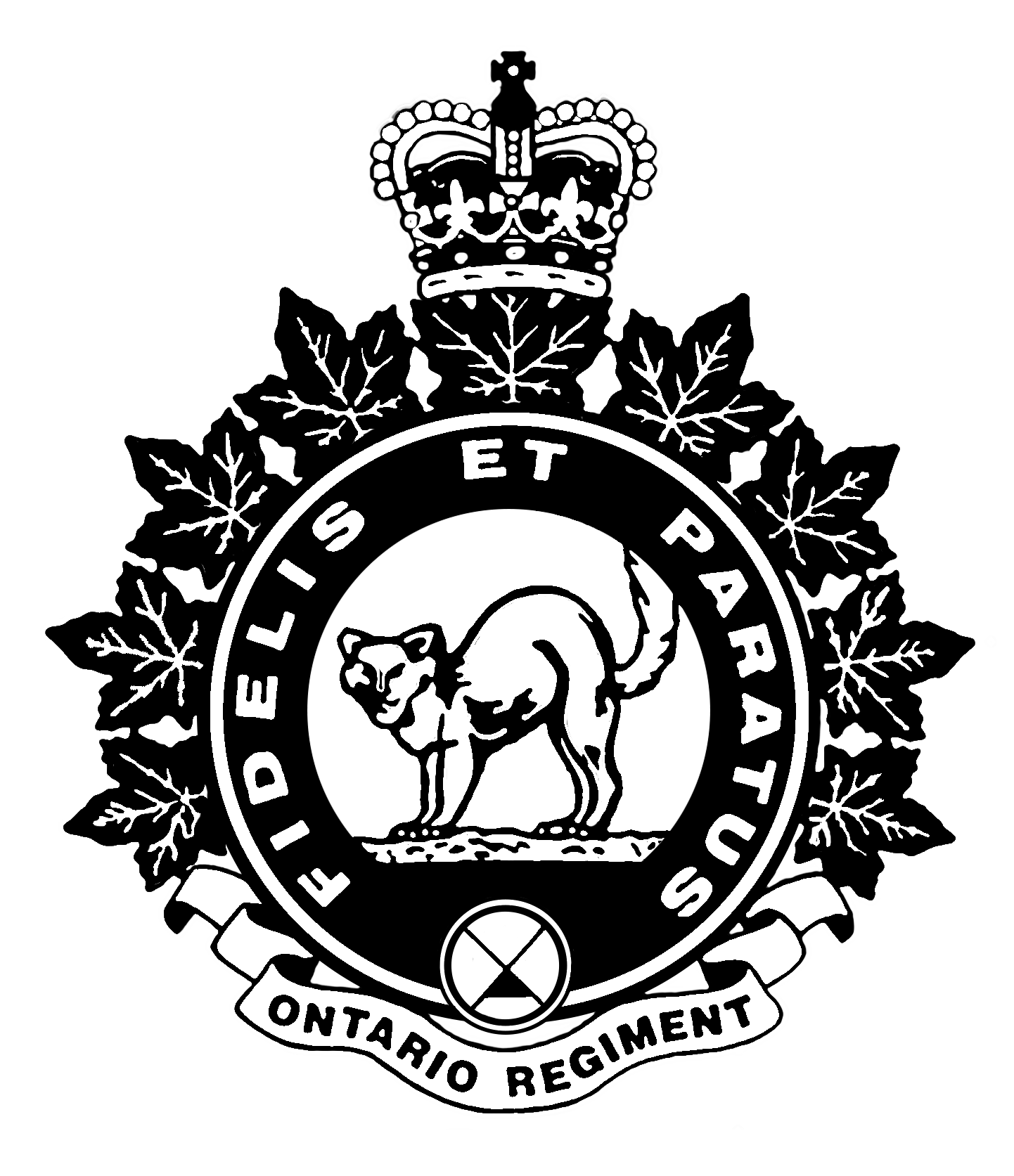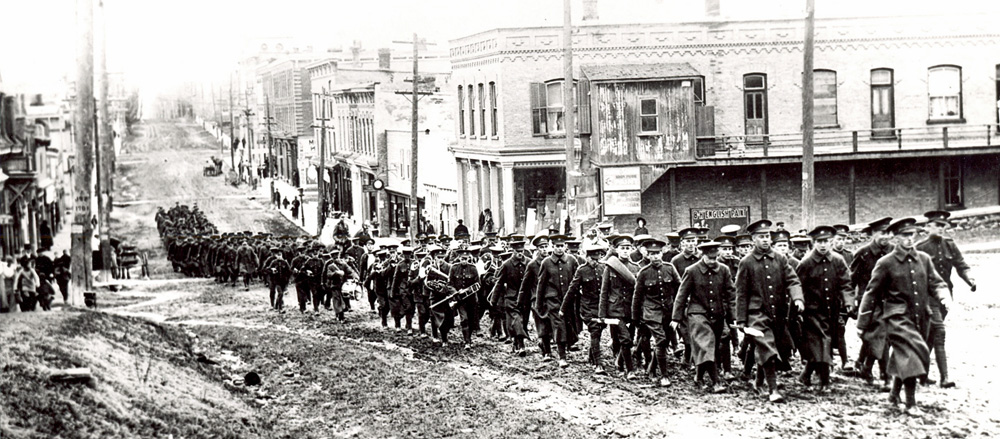Recruiting for the 116th Battalion, CEF began in the autumn of 1915, under the command of Lieutenant-Colonel Samuel S. Sharpe of Uxbridge. It was the first battalion of the CEF to be recruited entirely from a single county, its recruits coming from Ontario County. The Battalion was originally organized as follows:
HQ and “A” Company – Uxbridge with a platoon in Port Perry
“B” Company – Beaverton with platoons in Cannington and Sunderland
“C” Company – Whitby
“D” Company – Oshawa
Each of the companies trained locally through the end of 1915 and into the few months of 1916. In May 1916 the entire Battalion was brought together for the first time in Beaverton. The town in northern Ontario County was the starting point for the County march, a 75-mile, two-week trek that would take the Battalion through as many communities as possible. The goal of the march was to allow the citizens of Ontario County the opportunity to see their own battalion. It would also serve as a recruiting tool to sign-up the last few men required.
The County march was a huge event that month, garnering extensive newspaper coverage. Each community greeted the 116th Battalion with great enthusiasm and support. The downtowns were decorated and the streets lined with residents ready to greet the Battalion. Farmers provided the use of their horses and wagons to carry the soldiers’ baggage. When passing through towns where a stop was not scheduled, the men of the Battalion received handouts of fruit, sandwiches and drinks from the residents.
May 12: Beaverton
Oshawa’s “D” Company marched to Whitby, met with “C” Company, and both groups boarded a specially-booked train which stopped at Port Perry to pick up the platoon there before carrying on to Beaverton. A separate train took “A” Company from Uxbridge and made stops to pick up the Sunderland and Cannington platoons. All companies arrived in Beaverton in the morning and marched to the town hall where they were welcomed by local dignitaries. Billets were provided in the town hall, church basements and the Agricultural Society grounds. The first meal was served from the new field kitchen that evening.
May 13: Beaverton
The first of several displays of calisthenics was put on in the morning. The afternoon began with a public reception where several gifts were received. A motor ambulance was donated from the teachers and pupils of the County. A Ford truck was presented to the Battalion by Lady Margaret Mackenzie. The township of Brock donated $500 and another $400 came from private donations. Sports filled the rest of the afternoon.
May 14: Beaverton
A church parade was held in the morning as this was Sunday.
May 15: March to Cannington
The 116th marched to Cannington, arriving at noon, where a public reception was waiting for them at the town park. The following gifts were received:
- A mess tent from the town council
- $225 from the ladies of the town to purchase another tent
- $200 from Honorary Lieutenant-Colonel William J. Cowan to purchase equipment
- $75 from Robert Brandon to purchase equipment
- $25 from the Patriotic Society to Captain John Garbutt, the chaplain, to assist in his work
May 16: Cannington
It was intended to be a sports day, but rain caused the events to be cancelled.
May 17: March to Sunderland
The 116th marched west on the 12th concession to Highway 12 (the “centre road” in those days) and then south to Sunderland, arriving in the afternoon. Billets were provided at the old arena.
May 18: Sunderland
There was a reception and the presentation of a tent.
May 19: March to Uxbridge
The Battalion marched west from Sunderland to Udora where they stopped for lunch. This was a slight change in the original route march plan, but Udora was included after a delegation from that town requested that they be added. The next leg was straight south to Uxbridge, passing through Leaskdale on the way.
Word spread in Uxbridge that the Battalion was ahead of schedule, so the fire bell was sounded to warn the citizens of their approach. They were met at the outskirts of town by the town council, members of the school board and numerous children. The day’s march ended at the town park where the field kitchens were already set up and a large number of pies and other desserts, donated by the citizens of Uxbridge, awaited the hungry soldiers.
May 20: Uxbridge
It was a big day for the 116th Battalion. A set of colours, both a King’s and a Regimental, were presented to the Battalion by John Godfrey on behalf of the Junior Relief Club of Uxbridge. The ceremony took place at Elgin Park. During the ceremony the colours were received by Sergeants Frederick H. Stephens, Ernest H. Nutting and Gerard McDonald who then turned them over to Lieutenants Thomas W. Hutchison and Harold V. Gould.
In addition to the colours, the 116th also received:
- $500 from the Mayor on behalf of the town
- A marquee tent from Scott township
- A field kitchen
- A cheque from the funds left over after raising money for a field kitchen
The ceremony ended with a display of calisthenics and then a march through the town.
May 21: Uxbridge
A church parade was held in the morning as this was Sunday.
May 22: March to Port Perry
The Battalion left Uxbridge in the early afternoon and marched to Port Perry by Reach Road. A planned reception did not materialize due to the heavy rain. The soldiers went directly to their billets to dry off.
May 23: Port Perry
The Battalion assembled at the fairgrounds for yet another display of calisthenics. This was followed by a parade through town.
May 24: Port Perry
The motor ambulance previously presented in Beaverton was presented a second time, but now on behalf of the teachers and students of the south end of the County. It was Victoria Day, so the rest of the day was given to holiday celebrations.
May 25: March to Whitby
The day’s march first took the Battalion to Manchester, then south on “the stone road” (likely today’s Highway 12), swung east to Columbus and then back to Brooklin for lunch. The last leg of the day’s journey ended in Whitby. When the Battalion was about two miles north of Whitby, it was met with a motorized and horse-drawn delegation of public officials, businessmen and clergy who escorted them the rest of the way. The march ended at the town park (now Rotary Centennial Park).
Mayor Frank Warren welcomed the 116th with words of praise for Lieutenant-Colonel Sharpe’s success in raising the Battalion. A cheque for $200 was presented to Sharpe. The men were billeted in the town hall, the council chambers, the library, various churches and in any spare room that businesses had available. Supper was served in the Town Park, making use of the Battalion’s field kitchens.
May 26: Whitby
The Battalion gave a demonstration of calisthenics in the morning at the town park. The afternoon was declared a public holiday in Whitby and a large crowd gathered at Joseph Mitchell’s fifty acre field located on the south-west corner of Dundas Street West and Annes. The 116th Battalion participated in a mock battle for the enjoyment of the spectators. The events concluded with another demonstration of calisthenics and then a march-past in honour of the town. Refreshments were served to the Battalion before they marched back to the town park.
May 27: March to Oshawa
It was a short march along Kingston Road (Highway 2) to Oshawa, with the Battalion arriving at 10:30 am. They were billeted in the armoury, town hall and various churches. Thousands of Oshawa’s citizens lined the streets at 2:00 pm to see the 116th Battalion march through Oshawa. The parade ended at Alexandra Park where another large crowd was waiting. Mayor Gordon Conant welcomed the Battalion with a short speech.
The following gifts were presented:
- A tent from the Women’s War Relief Society
- A typewriter from Miller Brothers
- A cheque to assist Captain John Garbutt, the chaplain, in his work from the Girls’ Y Club
- A Chevrolet from George McLaughlin on behalf of the Chevrolet Motor Car Company of Canada (owned by the McLaughlin family)
Following the presentations, Lieutenant-Colonel Sharpe thanked the town for its generosity and the Battalion gave three cheers for Oshawa. The 116th put on a drill demonstration and then were served lunch.
Oshawa was the final stop on the County march. The Battalion remained in Oshawa until May 30 when they marched to Whitby and boarded the steamer Chippewa for the trip to Camp Niagara. At Niagara they conducted more advanced training until July 20 when they left the camp for the journey to England, and ultimately, the front lines in France in February 1917.
Rod Henderson
Rod Henderson is the Regimental Historian of the Ontario Regiment. He served as a Sergeant in the Regiment and is the author of “Fidelis Et Paratus: The History of The Ontario Regiment RCAC”.


